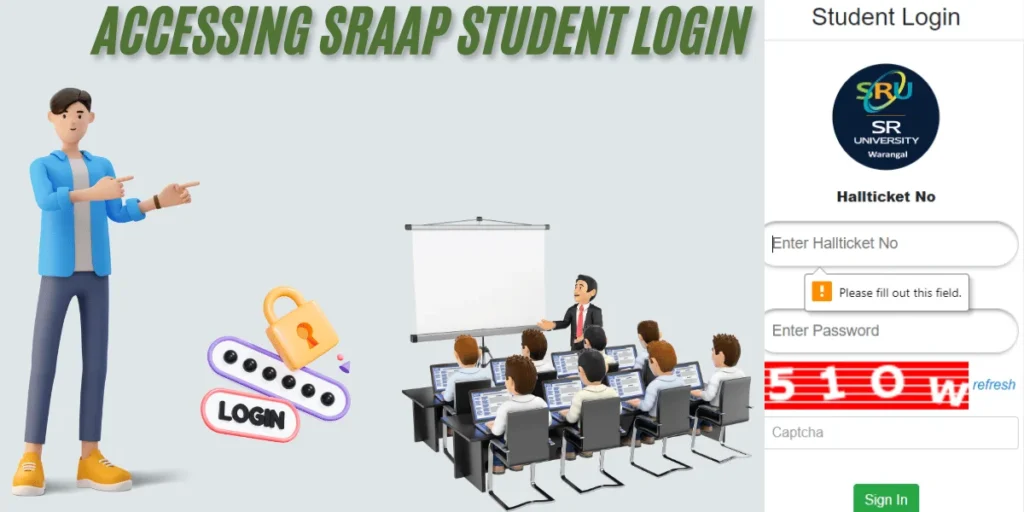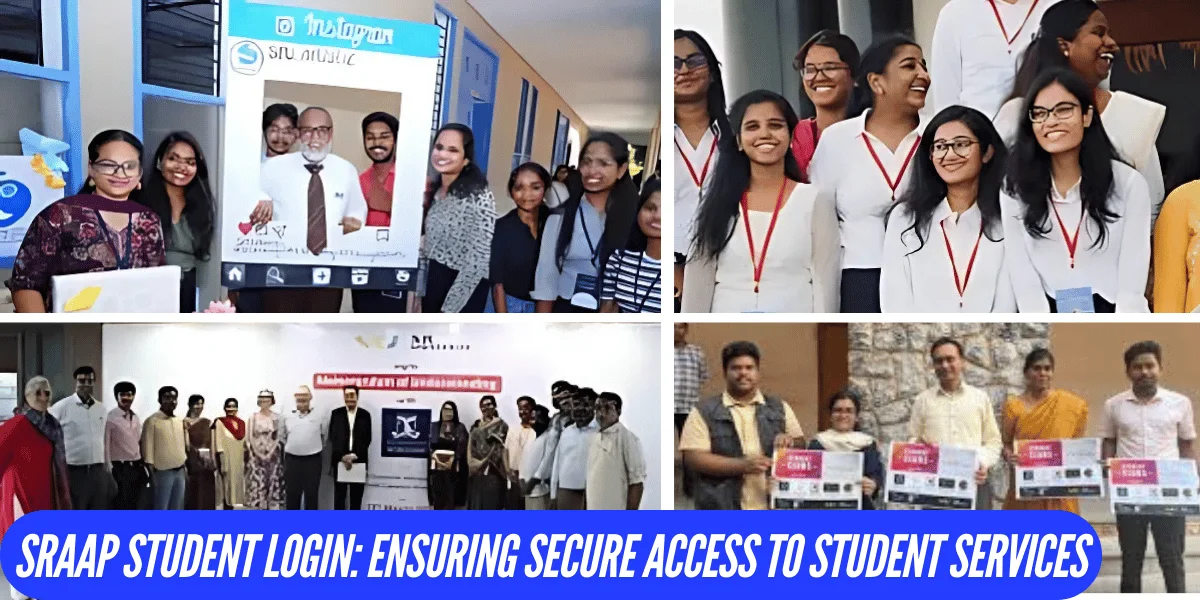In the fast-evolving educational landscape, the reliance on digital platforms to facilitate learning and administrative processes has never been more crucial. One of the most significant advancements in this domain is the SRAAP Student Login portal. This platform provides students with secure access to essential services and information, simplifying their academic journey. In this comprehensive article, we will delve into the various features of the SRAAP Student Login, discuss the importance of security and privacy, and explore how this system enhances the overall student experience.
What is SRAAP?
SRAAP, which stands for Student Resource and Academic Access Portal, is an integrated online platform designed to centralize a wide range of services and resources for students. This system serves as a gateway for students to manage their academic life effectively. From course registration and grade tracking to communication with faculty, SRAAP aims to streamline various processes to enhance student engagement and success.
Key Features of SRAAP Student Login
The SRAAP Student Login portal is equipped with a multitude of features aimed at improving the student experience. Some of the most notable features include:
- Centralized Access to Resources: SRAAP provides students with a unified platform where they can access essential academic resources, including course materials, academic calendars, library services, and more. This centralization reduces the time spent navigating multiple websites or systems.
- Course Registration and Management: The portal allows students to register for classes, drop courses, and manage their schedules effortlessly. This feature ensures that students can make timely decisions about their coursework.
- Real-Time Grades and Transcripts: Students can view their grades as soon as they are posted by instructors. The option to request official transcripts through the portal also simplifies the process of academic documentation.
- Communication Tools: SRAAP integrates messaging systems that facilitate direct communication between students and faculty members. This feature enables quick responses to questions and fosters a collaborative learning environment.
- Financial Aid and Billing Management: The platform allows students to manage their financial aid applications, check the status of their funding, and view billing statements. This financial transparency is crucial for students planning their budgets.
- Personalized User Dashboard: Upon logging in, students are greeted with a dashboard tailored to their individual needs. The dashboard provides quick access to frequently used services, notifications, and important deadlines.
Why Security Matters in Student Portals
As educational institutions move towards digital solutions, the security of online platforms becomes increasingly vital. The SRAAP Student Login system places a strong emphasis on security measures to protect students’ sensitive data. Here are some key security features integrated into the platform:
- Data Encryption: All data transmitted through the SRAAP portal is encrypted using advanced encryption protocols. This measure safeguards against unauthorized access, ensuring that students’ personal and academic information remains confidential.
- Two-Factor Authentication (2FA): To bolster security further, SRAAP employs two-factor authentication. This process requires users to provide an additional verification method, such as a one-time code sent to their mobile device or email, making it more difficult for unauthorized users to gain access.
- Regular Security Audits: SRAAP conducts frequent security audits and assessments to identify and mitigate potential vulnerabilities. These audits ensure that the system is up to date with the latest security protocols and best practices.
- Role-Based Access Controls: The SRAAP system implements role-based access controls, restricting access to sensitive data based on user roles. This means that only authorized personnel can access specific information, thereby reducing the risk of data breaches.
- Compliance with Privacy Regulations: SRAAP adheres to privacy regulations such as FERPA (Family Educational Rights and Privacy Act), ensuring that student information is handled responsibly and ethically.
Accessing SRAAP Student Login: A Step-by-Step Guide

Getting started with SRAAP Student Login is a straightforward process designed to be user-friendly. Here’s a step-by-step guide to accessing the portal:
- Navigate to the Official SRAAP Website: Begin by visiting your institution’s official SRAAP website. The URL is typically provided by your school during the registration process.
- Locate the Student Login Section: On the homepage, find the “Student Login” or “SRAAP Student Login” button, usually positioned in the upper right corner.
- Enter Your Credentials: Click the login button, and you will be prompted to enter your username and password. These credentials are typically provided upon enrollment or registration.
- Complete Two-Factor Authentication (if required): If your institution has implemented 2FA, you will need to verify your identity using a secondary method, such as a code sent to your mobile device.
- Access Your Dashboard: Once logged in, you will be directed to your personalized dashboard, where you can access various student services and resources.
Common Login Issues and Solutions
While accessing the SRAAP Student Login portal is generally a smooth process, students may occasionally face challenges. Here are some common issues and their solutions:
- Forgotten Password: If you forget your password, click on the “Forgot Password?” link on the login page. Follow the prompts to reset your password via the email associated with your account.
- Account Lockout: Entering incorrect login credentials multiple times may temporarily lock your account for security purposes. Wait for a specified period or contact your institution’s IT support for assistance in unlocking your account.
- Browser Compatibility Issues: Some login issues may arise from using outdated browsers. Ensure you are using a compatible and up-to-date web browser for optimal performance.
- Scheduled Maintenance: Occasionally, the SRAAP system may undergo scheduled maintenance, leading to temporary inaccessibility. Check your institution’s website or social media channels for announcements regarding system downtime.
- Clearing Browser Cache: If you experience persistent issues, clearing your browser cache and cookies can help resolve technical glitches and improve performance.
Benefits of SRAAP Student Login for Students
The SRAAP Student Login system provides numerous advantages that contribute to a better overall student experience:
- Enhanced Time Management: By centralizing access to various services, students can manage their time more efficiently. This consolidation reduces the time spent navigating multiple platforms, allowing students to focus on their studies.
- Improved Communication and Collaboration: The integrated communication tools promote better interaction between students and faculty, facilitating a collaborative and engaging learning environment.
- Access to Important Resources: With easy access to grades, course materials, and academic resources, students can stay informed and make data-driven decisions about their educational paths.
- Greater Financial Transparency: By managing financial aid and billing information through the portal, students can make informed financial decisions and plan their budgets effectively.
- Empowerment and Autonomy: The SRAAP Student Login empowers students by providing them with the tools and resources they need to take charge of their academic journey. This autonomy encourages students to be proactive in their education.
Enhancing Student Privacy and Data Protection
In addition to security, protecting student privacy is a critical component of the SRAAP Student Login system. Institutions must implement policies and practices that ensure the confidentiality of student data. Key measures include:
- Privacy Notices: Institutions should provide clear privacy notices outlining how student data is collected, used, and shared. Transparency fosters trust between the institution and students.
- Data Minimization: SRAAP adopts a data minimization approach, collecting only the information necessary for providing services. This practice reduces the risk of data exposure.
- Secure Data Storage: Student data should be stored securely, with robust access controls and encryption in place to prevent unauthorized access.
- Incident Response Plans: Institutions should have incident response plans in place to address data breaches promptly. Quick action can mitigate potential damage and protect student information.
- Regular Training and Awareness: Providing regular training for staff and students about data protection best practices enhances awareness and reduces the likelihood of security incidents.
Also read: xochitl gomez age | jungkook age | Sunny Sandler Age | Swasthya Ingit Login
Future of SRAAP and Student Portals
As technology continues to advance, the future of platforms like SRAAP looks promising. Innovations such as artificial intelligence (AI) and machine learning (ML) can further enhance the capabilities of student portals. Potential advancements include:
- Personalized Learning Experiences: AI-driven algorithms can analyze student behavior and preferences, offering personalized recommendations for courses, resources, and support services.
- Chatbots for Support: Implementing AI chatbots can provide instant support for common inquiries, improving response times and enhancing the overall user experience.
- Predictive Analytics for Student Success: Institutions can leverage data analytics to identify students at risk of underperforming and provide timely interventions to support their academic success.
- Mobile Applications: Developing dedicated mobile applications for SRAAP can enhance accessibility and convenience, allowing students to manage their academic lives on the go.
- Seamless Integration with Other Services: Future developments may include seamless integration with other platforms, such as career services, mental health resources, and extracurricular activities, creating a holistic student experience.
Conclusion: SRAAP Student Login
The SRAAP Student Login portal represents a significant advancement in how educational institutions provide services to students. By offering secure access to essential resources and information, SRAAP enhances the overall student experience while prioritizing security and privacy. With features such as centralized access to resources, course registration, and integrated communication tools, the SRAAP Student Login empowers students to succeed in their academic endeavors. As technology continues to evolve, platforms like SRAAP will play an increasingly vital role in shaping the future of education, providing students with the tools they need to thrive in a digital world.
FAQ:
1. What should I do if I encounter issues during SRAAP Student Login?
If you experience login issues, refer to the troubleshooting section of this article or contact your institution’s IT support for assistance.
2. Is my personal information safe with SRAAP?
Yes, SRAAP prioritizes security and privacy. It employs encryption, two-factor authentication, and compliance with privacy regulations to protect your data.
3. Can I access SRAAP from my mobile device?
Yes, many institutions offer mobile-friendly versions of SRAAP or dedicated apps for convenient access.
4. How can I reset my SRAAP password?
Click the “Forgot Password?” link on the login page and follow the prompts to reset your password.
5. What resources are available through SRAAP?
SRAAP provides access to course materials, grades, financial aid information, library resources, and communication tools for students.


